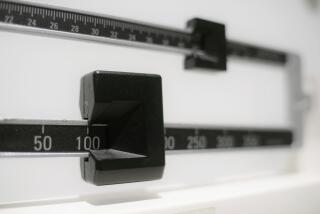Itâs not just how many calories, but what kind, study finds
A calorie is a calorie is a calorie â or is it?
Maybe not, a small study has found. Once the pounds are shed, the proportions of carbohydrates, proteins and fats you chow down on may determine whether you keep the weight off â or slowly but surely pack on pounds again.
In an intensive, seven-month experiment during which 21 overweight men and women had their diets strictly controlled down to each last morsel, researchers showed that a traditional low-fat diet seemed to make the metabolism more sluggish than a high-protein one during the most difficult part of weight loss: keeping fat off once itâs shed.
The preliminary work, which was published Tuesday in the Journal of theAmerican Medical Assn., provides support for a growing group of scientists who argue that what people eat may be just as key as how much they eat.
In a nutshell, âfrom a metabolic perspective, all calories are not alike,â said study senior author Dr. David Ludwig, director of the New Balance Foundation Obesity Prevention Center at Childrenâs Hospital Boston. âThe quality of the calories going in affects the quantity of the calories going out.â
Maintaining weight loss is a challenge that stymies the vast majority of dieters. Only 1 in 6 overweight and obese adults say they have ever held onto a loss of 10% body weight or greater for even a year, the team noted in its report.
Scientists knew that weight loss was accompanied by a slowdown in the bodyâs metabolism. To test whether different foods might influence that, Ludwig and his colleagues recruited overweight and obese adults ages 18 to 40. From 2006 to 2010, they marched the volunteers through several controlled feeding studies.
The 13 men and eight women followed a 12-week weight-loss regimen that helped them shed 10% to 15% of their body weight followed by a four-week weight-stabilization phase.
After that, each subject was fed three different diets for four weeks at a time: a traditional low-fat diet (60% carbohydrates, 20% fat and 20% protein), a low glycemic index diet (with 40% carbs, 40% fat and 20% protein) and a very low-carbohydrate diet a la Atkins (with 10% carbohydrates, 60% fat and 30% protein).
At the beginning of the study and at the end of each four-week stint, the subjects were hospitalized for three days to undergo a battery of tests. Scientists measured their resting energy expenditure using indirect calorimetry, which assesses gases in the breath to calculate calories burned.
They also looked at all the energy burned by the subject in a day using stable isotope analysis, which examines how rapidly isotopes leave the body over days and weeks.
The researchers also screened participantsâ blood and urine to record insulin sensitivity and levels of cholesterol, key hormones and other substances that are linked to a risk for heart disease or metabolic problems.
For all three diets, the rate of calories burned at rest was lower than before weight loss. But over the course of a day, the subjects burned more than 300 additional calories on average when on the verylow-carbohydrate dietcompared with the low-fat diet.
âThatâs roughly equal to an hour of moderate physical activity â without lifting a finger,â Ludwig said.
Subjects burned 200 additional calories on the low glycemic index diet than on the low-fat diet. A low glycemic index diet is rich in whole grains, fruits and vegetables and is designed to prevent sharp spikes in blood sugar.
Weight-loss experts not involved in the research praised it, while acknowledging its limitations.
âItâs a small study, so Iâd want to see it repeated. But I have no reason to doubt the result,â said Susan Roberts, a professor of nutrition and psychiatry at Tufts University in Boston.
However, University of Minnesota nutrition professor Joanne Slavin said that though the calorie-burning differences could work to peopleâs advantage, she worried that dieters would flock to low-carb diets that might be unhealthful.
âThe Atkins-type diet [in this study] only had 11 grams of fiber in it,â she noted. The recommended daily allowance for fiber in adults is at least twice that.
Ludwig also didnât recommend a very low-carb diet even though it offered the best metabolic edge. Some measurements suggested it could be risky for the heart, he said.
Blood samples drawn from participants in the low-carb diet phase contained elevated levels of the stress hormone cortisol as well as C-reactive protein, which signals chronic inflammation in the body and has been linked to cardiovascular disease.
The low-glycemic diet â which he has recommended for a long time â did not seem to have these problems, he said, making it the best bet.
But Roberts discounted the significance of the blood tests.
âI donât make anything huge of it,â she said. âYou need many more subjects to make that significant.â







